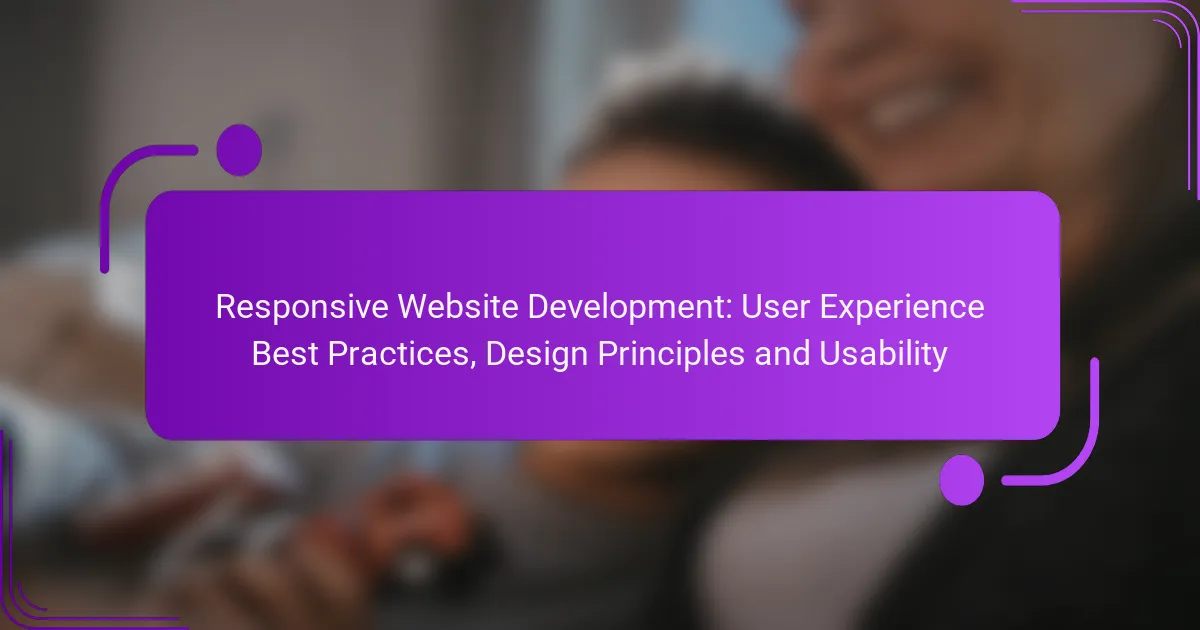Responsive website development is essential for enhancing user experience by ensuring that websites adapt seamlessly to different devices. By implementing key design principles such as fluid grid layouts and CSS media queries, developers can create intuitive and accessible interfaces that cater to all users. Prioritizing usability through consistent design and effective navigation further contributes to a positive interaction with the content.

How to enhance user experience in responsive web design?
Enhancing user experience in responsive web design involves creating websites that adapt seamlessly to various devices while providing intuitive navigation and fast loading times. Prioritizing accessibility ensures that all users can engage with the content effectively.
Mobile-first design approach
A mobile-first design approach starts by designing for smaller screens before scaling up to larger devices. This strategy ensures that essential features are prioritized, leading to a more focused user experience. It often results in faster load times and better performance on mobile devices.
To implement this, begin with a simple layout and progressively enhance it for larger screens. Use flexible grids and responsive images to maintain visual integrity across devices. This approach not only improves usability but also aligns with the increasing trend of mobile internet usage.
Intuitive navigation structures
Intuitive navigation structures are crucial for guiding users through a website effortlessly. Clear menus, logical categorization, and visible search options help users find what they need quickly. Avoid overly complex navigation that can frustrate visitors.
Consider using a hamburger menu for mobile devices to save space while keeping navigation accessible. Ensure that the most important links are easy to find, and use descriptive labels that clearly indicate their purpose. Regularly test navigation with real users to identify pain points and areas for improvement.
Fast loading times
Fast loading times significantly enhance user experience by reducing bounce rates and increasing engagement. Aim for load times under three seconds, as users tend to abandon sites that take longer. Optimizing images, leveraging browser caching, and minimizing HTTP requests are effective strategies to improve speed.
Utilize tools like Google PageSpeed Insights to analyze your website’s performance and identify areas for optimization. Regularly monitor loading times across different devices to ensure consistent performance. Remember, a faster site not only improves user satisfaction but can also positively impact search engine rankings.
Accessible content for all users
Accessible content ensures that all users, including those with disabilities, can navigate and interact with your website. Implementing accessibility standards, such as the Web Content Accessibility Guidelines (WCAG), helps create a more inclusive experience. This includes using proper contrast ratios, alt text for images, and keyboard navigability.
Regularly audit your website for accessibility issues and involve users with disabilities in testing. Providing multiple formats for content, such as text alternatives for videos, can further enhance accessibility. By prioritizing inclusive design, you not only comply with regulations but also expand your audience reach.

What are the key design principles for responsive websites?
The key design principles for responsive websites include fluid grid layouts, flexible images and media, and CSS media queries. These principles ensure that a website adapts seamlessly to various screen sizes and devices, enhancing user experience and accessibility.
Fluid grid layouts
Fluid grid layouts use relative units like percentages instead of fixed units like pixels to define the size of elements. This approach allows the layout to resize proportionally as the viewport changes, maintaining visual harmony across devices. For example, a layout that uses a 50% width for two columns will stack them vertically on smaller screens.
To implement fluid grids effectively, consider using a 12-column grid system, which is commonly used in web design. This system provides flexibility and helps maintain consistency, allowing for easy adjustments based on screen size.
Flexible images and media
Flexible images and media automatically adjust to fit within their containing elements, ensuring that they do not overflow or distort on different devices. This can be achieved by setting the maximum width of images to 100% and using height auto to maintain aspect ratios. For instance, an image set to max-width: 100% will scale down on smaller screens while retaining its original proportions.
When embedding videos or other media, use responsive techniques such as the “padding-bottom” trick to maintain aspect ratios. This ensures that media elements resize appropriately without compromising the layout.
CSS media queries
CSS media queries allow developers to apply different styles based on the characteristics of the device, such as screen width, height, and orientation. By using media queries, you can create breakpoints where the layout and design adapt to provide an optimal viewing experience. Common breakpoints include 320px for mobile, 768px for tablets, and 1024px for desktops.
To effectively use media queries, start with a mobile-first approach, designing for smaller screens first and then progressively enhancing for larger devices. This method ensures that essential content is prioritized for mobile users while still providing a rich experience on larger screens.

How to improve usability in responsive web development?
Improving usability in responsive web development involves creating a seamless experience across various devices. Key strategies include user testing, maintaining consistent design elements, and ensuring clear call-to-action buttons.
User testing and feedback
User testing is essential for understanding how real users interact with your responsive website. Conducting tests with diverse groups can reveal usability issues that may not be apparent during the design phase.
Gathering feedback through surveys or usability sessions can help identify pain points. Aim for a mix of qualitative and quantitative data to guide your adjustments effectively.
Consistent design elements
Consistency in design elements enhances usability by creating a familiar environment for users. Use uniform colors, fonts, and layouts across all pages to help users navigate effortlessly.
Establish a style guide that outlines these design principles. This guide should be referenced throughout the development process to ensure all team members adhere to the same standards.
Clear call-to-action buttons
Clear call-to-action (CTA) buttons are crucial for guiding users toward desired actions. Ensure that these buttons are visually distinct and use concise, action-oriented text.
Position CTAs strategically within your layout, making them easily accessible on both mobile and desktop versions. Test different placements and wording to determine what resonates best with your audience.

What tools can assist in responsive website development?
Several tools can significantly enhance the process of responsive website development by streamlining design, prototyping, and performance analysis. Utilizing these tools can lead to better user experiences across various devices and screen sizes.
Bootstrap framework
Bootstrap is a popular front-end framework that simplifies responsive web design. It provides a grid system, pre-designed components, and JavaScript plugins, allowing developers to create mobile-first websites efficiently.
When using Bootstrap, consider customizing the default styles to align with your brand identity. This can help maintain a unique look while benefiting from the framework’s responsive capabilities.
Adobe XD for prototyping
Adobe XD is a powerful tool for designing and prototyping user interfaces. It enables designers to create interactive mockups that can be tested on various devices, ensuring a seamless user experience before development begins.
Utilizing Adobe XD’s collaboration features allows teams to gather feedback early in the design process. This can help identify usability issues and make necessary adjustments before moving on to coding.
Google PageSpeed Insights
Google PageSpeed Insights is a tool that analyzes the performance of a website and provides suggestions for improvement. It measures loading speed and responsiveness, which are critical for user satisfaction and SEO.
To optimize your site based on PageSpeed Insights recommendations, focus on minimizing image sizes, leveraging browser caching, and reducing server response times. Regularly testing your site can help maintain optimal performance as you make updates.

What are the common challenges in responsive web design?
Responsive web design faces several challenges that can impact user experience. Key issues include ensuring cross-browser compatibility, effectively prioritizing content, and optimizing performance across various devices.
Cross-browser compatibility
Cross-browser compatibility ensures that a website functions correctly across different web browsers. Developers must test their designs on popular browsers like Chrome, Firefox, Safari, and Edge to identify inconsistencies in rendering and functionality.
To address compatibility issues, use standardized HTML and CSS practices, and consider employing tools like BrowserStack for comprehensive testing. Regular updates to browsers can also introduce new challenges, so ongoing testing is essential.
Content prioritization
Content prioritization involves determining which elements of a website are most important for users on various devices. Mobile users often have limited screen space, making it crucial to display essential information prominently.
Utilize techniques such as responsive design frameworks and media queries to adapt content layout based on screen size. A common practice is to use a “mobile-first” approach, designing for smaller screens before scaling up to larger displays.
Performance optimization
Performance optimization focuses on improving load times and responsiveness, which are vital for user retention. Slow-loading sites can lead to high bounce rates, especially on mobile devices where users expect quick access.
To enhance performance, minimize file sizes through compression, optimize images, and leverage browser caching. Aim for load times under two seconds for optimal user experience, and regularly audit your site using tools like Google PageSpeed Insights to identify areas for improvement.

How to select a responsive web development agency?
Selecting a responsive web development agency involves evaluating their expertise, portfolio, and client feedback. Focus on agencies that demonstrate a strong understanding of user experience and design principles tailored to various devices.
Portfolio review
A thorough portfolio review is essential when choosing a responsive web development agency. Look for a diverse range of projects that showcase their ability to create adaptable designs across different platforms and screen sizes.
Pay attention to the quality of the websites, including aesthetics, functionality, and user engagement. Consider whether their past work aligns with your industry and specific needs, as this can indicate their capability to deliver a tailored solution.
Client testimonials
Client testimonials provide valuable insights into an agency’s reliability and effectiveness. Seek out reviews that highlight their communication, project management, and ability to meet deadlines.
Look for feedback that specifically mentions the agency’s responsiveness to changes and their commitment to user experience. Positive testimonials can often indicate a strong partnership potential, which is crucial for successful project execution.
